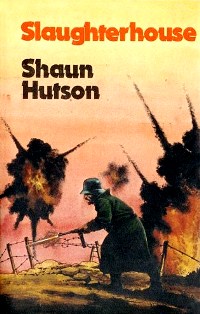
First published back in April of 1983, Shaun Hutson’s novel ‘Slaughterhouse’ formed the fourth instalment within his ‘Sergeant Rolf Kessler’ WWII war series. The novel was originally published in hardback under the author’s name of Shaun Hutson, and later re-released in paperback under the pseudonym Wolf Kruger.
The first edition hardbacks are now highly sought-after collector’s items, regularly selling for considerable amounts through online auction websites and second-hand dealerships.
DLS Synopsis:
The Germans had been entrenched along the Eastern Front for nearly two months, with Sergeant Rolf Kessler’s Special Assault Section – Sledgehammer – having joined the troops in this hellhole a little over six weeks ago. A couple of hundred yards away, the Russians lay waiting in their own trenches, dug in and holding their ground against any attack the Germans threw at them. Russian mortar shells pounding the landscape in an unending barrage of defiance.
Every day the troops heard rumours of an offensive. The daily build-up of German guns and armour would indicate an attack was in the offing. But to the men of Sledgehammer, such an assault seemed out of the question while the ground was in its present glutinous state.
However, Kessler knew only too well the stupidity of the High Command. Each day he waited for the order for an attack to come through. The offensive, when it finally came, would be no easy affair. Stalin’s forces had been given time to regroup and to prepare themselves for the next German assault. With the weather, the increasingly fierce resistance from the Russians, and the low German morale, Kessler knew that the next offensive could well prove the undoing of the Wehrmacht.
But for Kessler, his immediate concern was for the men under his command. The men of Sledgehammer. They were seen to be the finest fighting unit along the Eastern Front. However, there was only so much one assault section could do alone. And without backup, without a competent army to support Kessler’s men, they’d be left high and dry facing the Russians alone...
Admittedly, the synopsises DLS Reviews provide with their in-depth dissections often detail a fair amount of what occurs in the opening chapters of the books. Hopefully not so much spoilers as they are indicators of what to expect in the tale. The above synopsis again provides the initial setting for the plot – the base premise from which the novel then progresses from. However, the synopsis that accompanies the book, the one printed on the inside of the hardback dust jacket, or on the back cover of the paperback, gives away a hell of a lot more. If you read the official synopsis, then it tells you what happens during the first two-thirds of the book! So, if you’ve not read this novel yet but are planning to at some stage, then I strongly recommend you don’t read the synopsis that accompanies it before embarking upon the tale, otherwise you’ll be faced with some pretty serious spoilers.
Anyway, on to the review. What we have here is another solid addition to Hutson’s ‘Sergeant Rolf Kessler’ war story series. It’s a tale that can be read and enjoyed in isolation. There’s certainly no real need to have read the three preceding instalments before cracking on with this one. However, there are brief references back to key moments from the previous books. Furthermore, Hutson doesn’t go to any length to introduce the various members of the Sledgehammer Assault Section in this instalment. Therefore, without having the previous novels under your belt, you’ll be missing some elements about the characters background which do add to the tale. Although as I said, it’s not exactly plot critical.
The tale feels like its pretty much carved into four distinct sections. The pre-offensive chapters, those of the chaotic assault, the chapters following the assault (the official synopsis gives away what this entails, although DLS won’t), and finally the ‘slightly-longer-than-necessary’ final chapters following the unit’s return to the German trenches (don’t worry, that’s not a spoiler – let’s be honest, Sledgehammer’s survival is obvious).
The tale has a surprisingly reserved first few chapters before any real meaty action takes place. It’s certainly not a usual Hutson style beginning. Instead we see our favourite German troop, sitting around in the muddy trenches, reading porn mags, playing cards and partaking in jovial banter.
Here Hutson does sketch out the members of Sledgehammer, for those new to the series, with their various characteristics brought to the forefront whilst they sit around waiting for the next German offensive to be announced. However, there’s not much time spent on this, and instead, Hutson focuses the narrative on Kessler’s frustration with High Command, and the lack of descent support for his unit.
It’s once the full-blown assault on the Russian front gets underway when the novel really starts to pick up pace. From here on in it’s brutal fighting followed by some pretty darn tense action sequences, showing the tough decisions faced by those on the front line and those finding themselves behind enemy lines.
However, where Hutson’s war stories excel is with the honesty given to his characters. Yeah, Kessler’s our principal protagonist. He’s the hero of the books. However, he’s not always portrayed as the courageous, laughs-in-the-face-of-danger type. Instead he’s human. A man who knows his own and his unit’s limits. Kessler’s first and paramount concern is always with protecting those in his command. It’s something displayed in surprising clarity within this tale. And for me, this element of gritty, human reality, enriches the story that much more.
It would be fair to say ‘Slaughterhouse’ isn’t the most accomplished of Hutson’s war stories. The narrative is very linear, with pre-plotted stages leading us through the rough and tumble of the fighting and drama. Nevertheless, it certainly has its moments – some of which are pretty darn gritty.
The book is a solid addition to the series. Nothing more, nothing less. Although it does introduce Colonel Klaus Schrodek’s son to the unit, in a slightly odd final couple of chapters which deliver a sort of petering out feel to the book’s conclusion, rather than an explosive ending. But it’s good to see some continuation being included.
So yeah, another solid addition!
The novel runs for a total of 157 pages.

© DLS Reviews









